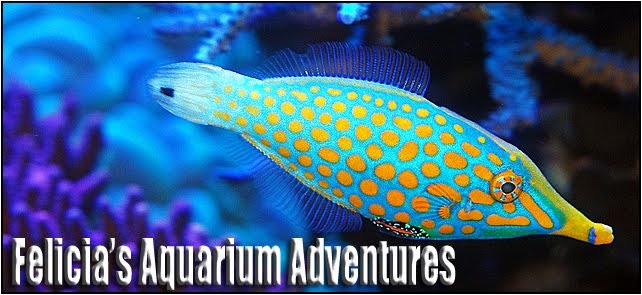A post from the 2009 Reef Tools visit to LiveAquaria and Drs. Foster & Smith
"ReefTools visits Drs. Foster and Smith and LiveAquaria part 2
Posted on Friday, July 2nd, 2010 at 1:02 pm by Reef Tools
A lot of you have asked for the second part in this series, so here it comes. If you have not had a chance yet, check out ReefTools visits Drs. Foster and Smith and LiveAquaria part 1. We have visited LiveAquaria now for a second time this year, so we will incorporate photos from both visits into this article. If you haven’t had chance to read about LiveAquaria, you don’t know what you’re missing. Many of you have probably ordered both Dry Goods and Livestock from LiveAquaria and Diver’s Den, without knowing much about the company and their setup. Well, we’re here to give you a behind-the-scenes look.
We entered the facility and were immediately greeted by LiveAquaria’s director Kevin Kohen. The first thing we noticed when entering the “coral farm,” is just how clean and organized everything was. The coral farm is comprised of several raceways, where every inch is covered with healthy and colorful corals and clams. East bin in the raceway has a dedicated metal halide fixture on an automated track. The light is constantly moving back and forth to cover the entire tank. This allows the facility to provide the corals the light they need, while saving energy. There are 3 separate coral systems, each with their own controller, skimmer, calcium reactor, kalk reactor, etc. Immediately in front of you, is the quarantine and medication station for fish, where new arrivals are treated. The knowledgeable staff at LiveAquaria places a high priority to provide the livestock with excellent care.
To the right of the fish quarantine station, you will see LiveAquaria’s coral quarantine station, containing several large containers where each coral is placed after being dipped. This setup allows the staff to inspect each and every piece that comes in, and identify any pests that it might carry. The corals are left in the Quarantine station until they are ready to be introduced to one of the main systems. This prevents any pests from entering one of the large coral system. Pay attention here, EVERY CORAL IS DIPPED AND QUARANTINED!! If LiveAquaria puts forth the time, money and effort with 100,000’s of pieces of livestock each year, maybe you should do the same to any new piece you add to your system.
As you walk out of the coral Quarantine station, you come face to face with an incredible show tank. This 265 (84 x 24 x 30) gallon tank is stacked with the most incredible SPS you’ll ever see. Large Acropora colonies “plague” this beautiful tank, along with a wonderful selection of fish and invertebrates (love the Harlequins). From Australian Echinatas, to Acroporas from Fiji and Bali, this tank is enough to make any coral enthusiast drool. If you can pull yourself away from the show tank, you begin your tour of the coral raceways.
I can’t say enough about how nice and healthy the corals, clams, and other inverts were. These are the items you see in the Diver’s Den section of www.liveaquaria.com. Each raceway provides a beautiful top-down view of the livestock, and you can see 360 degrees of pretty much every piece. The raceways seem to just go on and on, with every shade of color you could possibly add to your tank. Once you make your way through the raceways, you enter the Diver’s Den fish section. Most fish are kept in their own container, were they are continuously inspected throughout every day, until they are sold and shipped. Even with the massive quantity of fish, the staff knew exactly what was available, and where it was. We enjoyed seeing some rare species occupying many of these tanks. A huge advantage of this setup, is that it allows the staff to ensure that each fish is eating. LiveAquaria prides itself on selling healthy, almost all of which are used to eating frozen food. This greatly increases the likelihood that your new acquisition from LiveAquaria will do so in your system. This is very important, especially for finicky eaters, or difficult to keep fish.
We can’t say enough about the amount of care given to the livestock, as well as the extreme attention to details provided by the LiveAquaria staff. LiveAquaria offers a 100%, arrive alive, stay alive, risk-free 14 day guarantee on fish, coral, plant, or invertebrates. A 30 day guarantee is offered for each Drs. Fosters & Smith Certified Captive Grown coral.
Stay tuned to part 3 of this series. Please check out their site at www.liveaquaria.com."



























 ) and fills the extra space with bio-degradable packing peanuts (which they house is huge holding rooms). This Green approach to packing, is just DFS doing their part in conserving the environment. Once the orders are ready to be shipped, DFS employees load up a slew of FedEx trailers which have their own parking lot at the facility. DFS ships so many orders, that they actually sort the packages for FedEx, based on their destination. Overall, the operation is top-notch, with every detail carefully planned and accounted for.
) and fills the extra space with bio-degradable packing peanuts (which they house is huge holding rooms). This Green approach to packing, is just DFS doing their part in conserving the environment. Once the orders are ready to be shipped, DFS employees load up a slew of FedEx trailers which have their own parking lot at the facility. DFS ships so many orders, that they actually sort the packages for FedEx, based on their destination. Overall, the operation is top-notch, with every detail carefully planned and accounted for.

